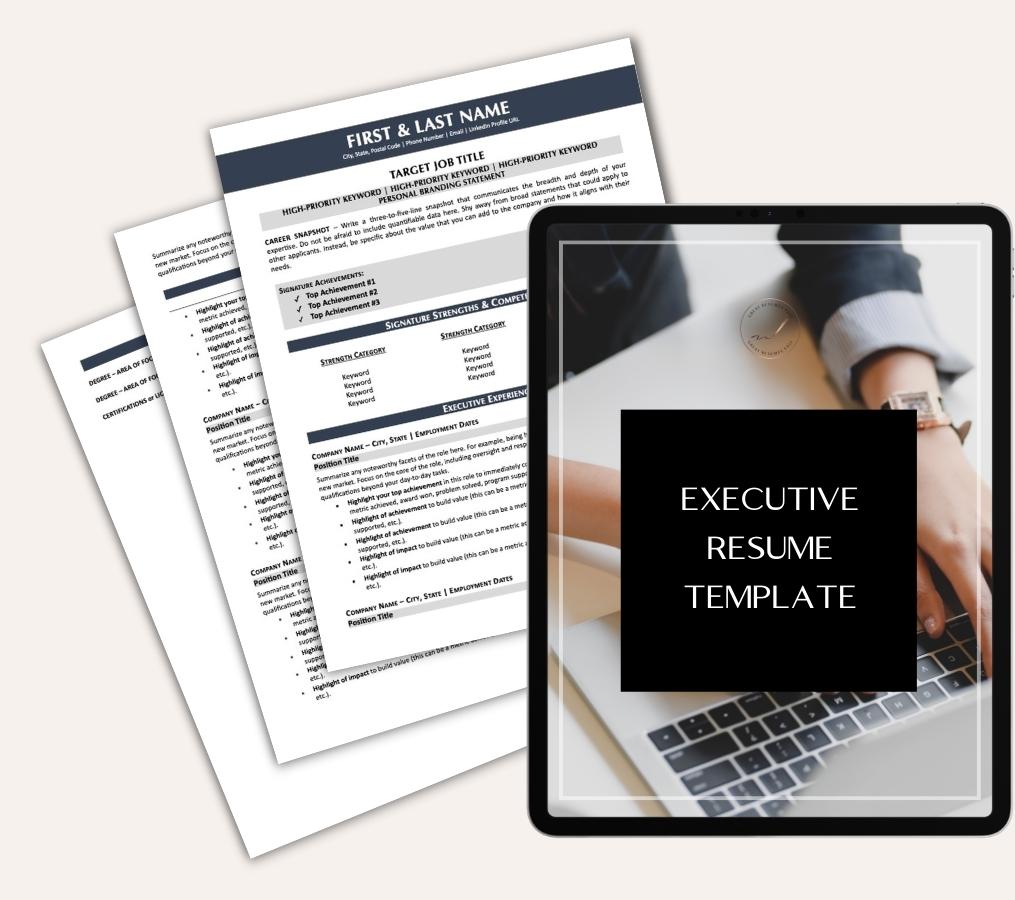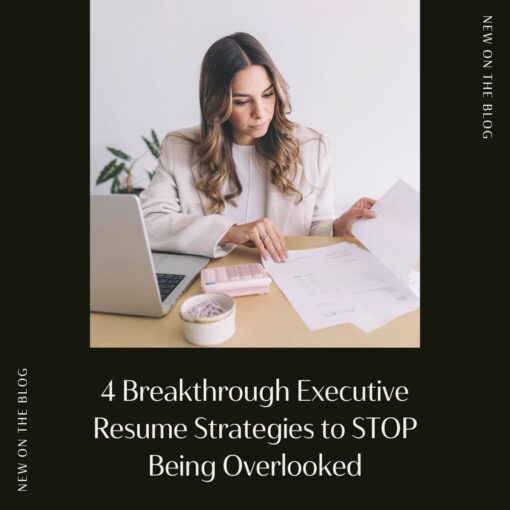Halt Constant Rejections with These 5 Smart Resume Tweaks
“Never thought I’d be in the position where I can’t even get a phone call for a position.”
“I’ve been job searching for 6 months with no interviews.”
Could anything be more disheartening than submitting resumes for roles you’re well-qualified for and receiving no response?
You have so much on your plate, and job searching feels like a second full-time job. Each day without an offer costs you real money you could get from higher earnings and an executive role for the next step up. Too much rejection affects your peace of mind, leading to doubt, insecurity, and despair.
I don’t want that for you or any job seeker. So, to halt constant rejections and turn the tables around, I’m going to give you five smart resume tweaks to impress recruiters instantly!

Smart Resume Tweak #1: Optimize the Top Third
The first third of your resume is by far the most critical. It’s what hooks the recruiter and hiring manager’s attention and entices them to keep reading the next section of your resume. It’s goal is to clearly and quickly convey a couple of key pieces of information.
- The job you’re targeting.
- That you’re qualified for the job you’re targeting.
As you answer these two questions the reader will keep going to find out if you’re the best fit for the role. That’s where the remainder of your resume comes into play. For now though, let’s optimize the first third of the resume so we can get the recruiter down to the rest of your resume and get more interviews.
These tweaks will optimize your resume:
– A street address isn’t necessary but you do want to include city, state, and zip code. This helps recruiters with location-based searches.
– Include your LinkedIn profile URL in the top section. Customize your profile URL if you haven’t yet and include it. You can even hyperlink it. This will point recruiters to where they can go to find out more great information about you.
– Add the target job title for the position you want. You can change this as you apply to different jobs. Be specific here so employers know exactly the role you want and there’s no room for confusion.
This one change alone helped one of my clients land 5 interviews in one week. It helped another land 7 interviews in 10 days. It works!
– Find the 3 highest-priority hard skills for the role and put them underneath the job title. This tells the recruiter scanning your resume you have the required skills. You’re increasingly connecting the dots for the employer so they know you’re a strong fit.
With these tweaks in place your resume should look something like this:

To make the format, design, and writing process easier, I created an executive resume template that you can download for free here. The image above comes from that template. It’s helped 25,000+ job seekers land their next executive role.
Now, let’s discuss that personal branding statement and why it’s so important.
Smart Resume Tweak #2: Bring in your personal brand
One of the main purposes of your resume is to help you STAND OUT from other applicants and not blend into the masses of applications.
In order to do that, your resume needs a personal branding statement that concisely conveys the unique value that you can offer the company.
This statement also needs to show how there is an alignment between your skills and experiences and the company’s needs. A perfect branding statement will marry your skills and their needs.
- Research the top three things the company needs for the target role.
- Consider the top three things you’re best at, where your strengths lie.
Is there a match where you can deliver what they need? This is where your branding statement comes in!
Here’s an example of the personal branding statement we wrote for one of our CEO clients:
“Building Top-Performing Logistics Teams That Raise the Bar on Supply Chain Excellence”
You can choose to be even more specific including dollars, percentages, or savings if applicable.
Take some time today to work on your personal branding statement and remember if you did it, it’s not bragging!
Smart Resume Tweak #3: Opt for a snapshot instead of a summary
When writing an executive career summary job seekers tend to fall into the trap of making broad generalizations. That’s why I recommend that instead of writing a summary of your career you create a snapshot instead.
Write three to five lines that communicate the breadth and depth of your expertise using keywords and skills. It’s preferable if you can include quantifiable data here. Avoid broad statements that could apply to other applicants.
Instead, be specific about the value that you can add to the company and how it aligns with their needs and make sure you’re working in a few high-priority keywords.
Here’s an example of what it might look like to turn a generic career summary into a data-driven snapshot:
Marketing Director who crafts data-driven campaigns that yield ROI upwards of 250%. Spearheaded multi-channel strategies, enhancing brand visibility by 180% in competitive markets. Pioneered a content marketing shift, resulting in a 320% boost in organic web traffic.
Notable highlights:
- Market analysis; leveraging insights to pinpoint and act on emerging trends.
- Brand positioning; establishing market presence in new segments leading to a 70% growth in customer base.
- Led cross-functional teams; consistently meeting project deadlines and reducing operational costs by 20%.
A couple of things I want to point out:
- I highlight the job title so that it would catch the recruiter’s eye. I did the same thing for three keywords that were important to the role. I wanted the recruiter to see how my client put these skills into action and delivered results.
- In the career snapshot, I was very specific. I didn’t give broad, sweeping statements. I used action verbs like spearheaded and pioneered and I added percentages. Notice how non of them have to do with money?
When writing your snapshot focus on specifics; skills, results, facts, figures, and keywords. Doing so intrigues the reader instantly and keeps them engaged reading your resume.
Smart Resume Tweak #4: Put significant accomplishments front and center
This is another way we are reeling in our reader. We hooked them with the first section of the resume and now we’re keeping them on the line by feeding them more information they want to read.
“Signature Accomplishments”. It looks like this:

This is my favorite section of the executive resume template download because it makes the information the recruiter wants easy to scan. When you make it easy-to-read they will read it.
This is where you want to list your top three career achievements.
These need to be relevant to your target role. So think about successes you’ve had in the past that would relate to the requirements listed in the job ad.
If there’s a top achievement that is something the company is looking for or needs as a part of the functions of the role you’re applying to you want to include it in this section.
Results need to be quantifiable so ask yourself how much, how many, where was there an increase or decrease? These answers will help you formulate your achievement bullets.
I recommend using the STAR framework when writing bullets.
It’s about painting a story.
Situation: The context.
Task: Your role.
Action: What you did.
Result: The tangible outcomes.
This adds depth, making your experiences relatable.
And don’t worry about the keyword section, those aren’t tables keeping the words in three neat columns. I’m using the columns feature so that it won’t mess up anything with applicant tracking systems (ATS) or resume parsing. Any systems scanning your resume will pick up every single keyword on it using this template.
Smart Resume Tweak #5: Win with word swaps
One of the struggles I see job seekers face every day is how to translate their experience into a resume that will impress employers. They’re not sure how to identify and share their achievements and so they end up using passive language that can actually harm their job search efforts.
Instead of writing a resume that highlights the standout value of achievements by quantifying them clearly many job seekers fall back to using terms like responsible for, duties included, or worked with.
These are all passive terms.
You also want to avoid phrases like results-driven, successful, or accomplished.
These don’t actually communicate any information of substance they take up space. If you find that you’re not getting responses from your resume submissions it’s likely that communicating the type of information that employers need.
It’s not enough to avoid passive language you need to replace it with action verbs.Start each bullet with an action verb.
Here’s a list of some of my favorites:
Use these terms to convey that you’ve led a project, department, or division:
- Chaired
- Coordinated
- Guided
- Headed
- Inspired
- Mentored
- Motivated
- Operated
- Oversaw
- Synchronized
Use the following terms if you brought an idea to fruition:
- Crafted
- Charted
- Choreographed
- Devised
- Enhanced
- Forged
- Fulfilled
- Implemented
- Pioneered
- Spearheaded
These are great alternatives to responsible for or duties included. Try starting the accomplishment bullets on your executive resume template with these instead.
Let’s make sure the world sees and hears your potential.
Put all five of these smart resume tweaks together with the free executive resume template that I created and you’ll not only halt the constant rejections but intrigue recruiters instantly so you get more interviews.
Now that you know how to optimize your resume what about optimizing your LinkedIn profile? I’ve got this article (What Most Job Seekers Get Wrong About LinkedIn) to help with that.
Share this post:

About the author
Jessica Hernandez, President, CEO & Founder of Great Resumes Fast
Hi, I’m Jessica. I started this company back in 2008 after more than a decade directing hiring practices at Fortune 500 companies.
What started as a side hustle (before that was even a word!) helping friends of friends with their resumes has now grown into a company that serves hundreds of happy clients a year. But the personal touch? I’ve kept that.
You might have seen me featured as a resume expert in publications like Forbes, Fast Company, and Fortune. And in 2020, I was honored to be named as a LinkedIn Top Voice of the year!
I’m so glad you’re here, and I can’t wait to help you find your next perfect-fit position!
Improve Your Resume: Download Your Free Executive Resume Template Today
Are you struggling to create an executive resume that will impress employers? Download this free executive resume template and receive a series of 10 emails with expert guidance on how to write resume content that resonates with employers so you get more interviews.
It's everything you need to stand out, make an impression, and accelerate your job search.








